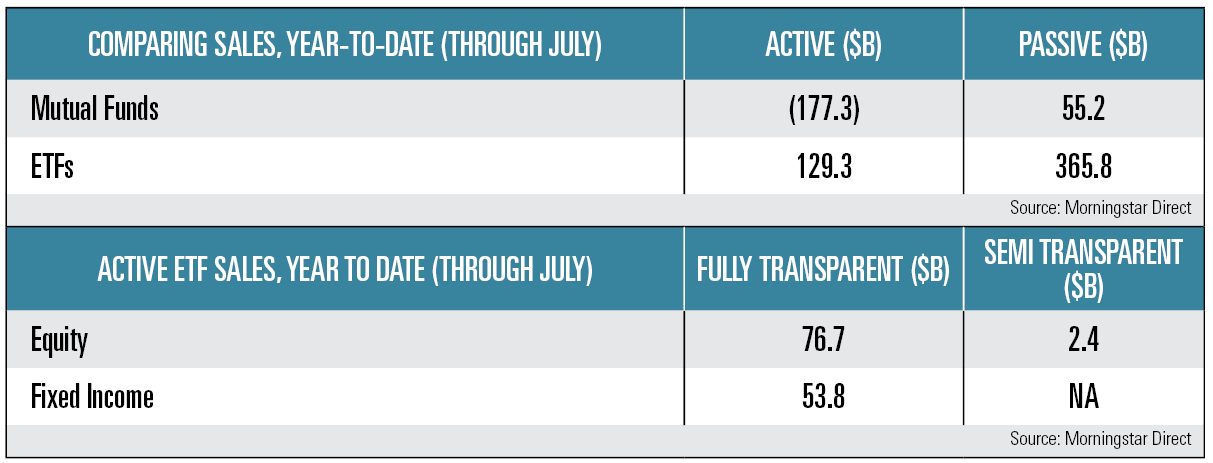

One of the hottest areas in retail investing is active ETFs, and asset managers have been queuing up to launch versions that mirror their mutual funds.
But one thing they haven’t been doing is pursuing semi-transparent or nontransparent structures – something that a few years ago was seen as the next big thing for ETFs. Instead, managers are launching products that are fully transparent, or that disclose their holdings daily, rather than showing a proxy basket that would give a general idea about what the ETFs invest in. And in some cases, ETF sponsors who brought the handful of semi-transparent products to the market are switching to fully transparent models.
One such firm, Gabelli, this month is making one of its five active ETFs fully transparent.
“As we’ve built the AUM and we’ve gone out to platforms, invariably the feedback we’ve gotten is … ‘We’d really like to see you in a transparent form,’” said Mac Sykes, portfolio manager of the Gabelli Financial Services Opportunities ETF, the product that is switching.
“We’ll get a look from the markets to see if that makes a difference. We’re doing it to get to an industry standard.… This is being viewed as a test case in making the change to fully transparent.”
Not disclosing holdings daily has had the effect of limiting distribution, and funds with semi-transparent or nontransparent models are also constrained to holding US-listed securities, Sykes noted. Having a wider range of securities to invest in would not change the ETFs’ strategies, but it does provide more flexibility, he said.
“Given that the bulk of the firms in our portfolio are mostly large-cap, well-known names, and that we also have a lower turnover, I don’t think it is a disadvantage to be providing that daily [holdings] file,” he said.
However, there is more of an argument for limited transparency for ETFs that focus on small-cap equities, he said.
Another firm, New York Life, last month rebranded its two ETFs that used a semi-transparent structure, switching them to be fully transparent.
Industrywide, there’s been almost zero interest recently in semi-transparent ETFs, with few if any launches in at least a year, said Jack Shannon, senior manager research analyst at Morningstar Research Services.
“The [active ETF] market in equities has really gone the fully transparent route,” Shannon said.
Firms he has spoken with about recent active ETF launches have said “it wasn’t even a discussion” about which level of transparency to use. Some fund sponsors waited on product launches to see how the semi-transparent model played out for others, and those firms have since opted to add ETFs with daily holdings disclosure, he said.
“I would be surprised if we have a lot of semi-transparent [ETFs] hit the market,” he said.
Some of the early semi-transparent ETF launches in 2020, such as products from Fidelity and T. Rowe Price, were clones of active mutual funds – and having limited holdings disclosure made more sense in those cases, he said.
“You don’t want to tip your hand on any moves,” he said. However, “I don’t think there was a clear value proposition for why people would want to switch from the mutual fund to the ETF.”
That has hardly stopped asset managers from lining up for approval by the Securities and Exchange Commission to add ETF share classes of existing mutual funds. Since Vanguard’s patent on that expired last year, numerous companies, including Dimensional, Franklin Templeton, Principal, Charles Schwab, PGIM, Fidelity, and Morgan Stanley have asked for the SEC’s blessing – although the commission has yet to approve the requests, including any across the industry for actively managed products. Only Vanguard’s passive funds have ETF share classes.
It’s clear that active managers see some opportunity in ETFs. As active mutual funds have been hemorrhaging assets, that hasn’t been the case for active ETFs. Active equity mutual funds have seen negative sales of $273.5 billion so far this year and negative $492.2 billion over 12 months, according to data from Morningstar Direct. Meanwhile, active equity ETFs pulled in $76.2 billion and $111.9 billion during those timeframes.
There is a caveat, Shannon said. Firms like Dimensional and Avantis have raked in much of the net sales, but those shops aren’t fully active in the sense of traditional stock picking, he said. Dimensional, for example, applies factor tilts to portfolios that are otherwise similar to indexes, he said.
And whether active management is going to be successful long-term has less to do with the varieties of product types and more to do with investors’ confidence in active, he said.
“It’s ultimately still a question of whether the clients believe in active management or not,” he said. “You’re not going to win the bids if they don’t believe in what you’re doing.”
Among financial advisors, about 90 percent use ETFs in some capacity, according to survey data from Cerulli. However, 61 percent of advisors told Cerulli that choosing active managers who will consistently outperform indexes is difficult.
“We consistently recommend passive ETFs instead of passive mutual funds because of tax benefits and the ability to transact at an immediate price. Now that ETFs settle as quickly as mutual funds, we see almost no advantages to mutual funds,” said Noah Damsky, principal of Marina Wealth Advisors, in an email. “We take an active approach in fixed income. The data suggests the opportunity to outperform the benchmark on a risk-adjusted basis is more likely in fixed income and equities. Fixed income has a less-liquid, more dislocated market, while equities are more efficient.”


Relationships are key to our business but advisors are often slow to engage in specific activities designed to foster them.

Whichever path you go down, act now while you're still in control.

Pro-bitcoin professionals, however, say the cryptocurrency has ushered in change.

“LPL has evolved significantly over the last decade and still wants to scale up,” says one industry executive.

Survey findings from the Nationwide Retirement Institute offers pearls of planning wisdom from 60- to 65-year-olds, as well as insights into concerns.
Streamline your outreach with Aidentified's AI-driven solutions
This season’s market volatility: Positioning for rate relief, income growth and the AI rebound
